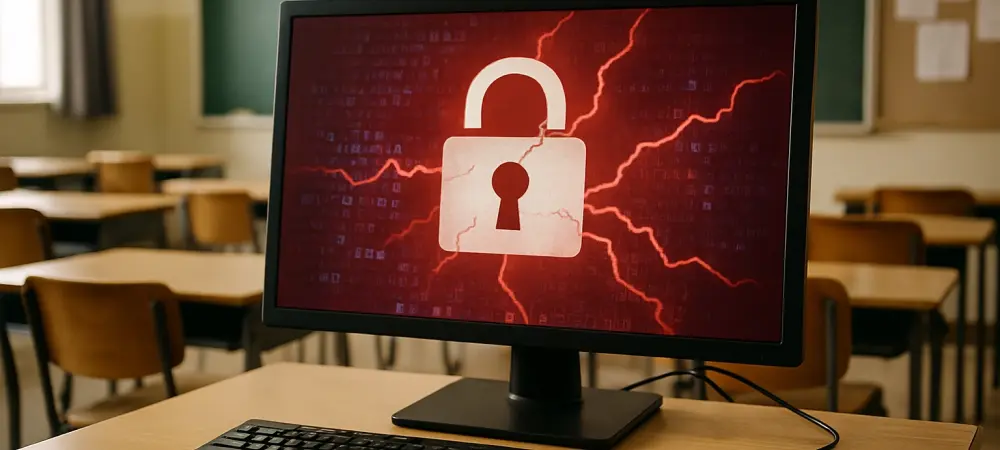Imagine a school district, a cornerstone of community education, suddenly thrust into chaos as hackers infiltrate its systems, exposing the personal data of thousands of individuals in a devastating cyberattack. This alarming scenario unfolded at School District Five of Lexington & Richland Counties in South Carolina, where a staggering 31,475 individuals found their sensitive information at risk. Reported on August 29, this breach has sent shockwaves through the region, raising urgent questions about the vulnerability of educational institutions to cyber threats. With names, Social Security numbers, and financial details compromised, the incident underscores a growing crisis in school cybersecurity, demanding immediate attention and action.
Breaking Down the Cybersecurity Crisis in School District Five
On June 3, unauthorized access was detected in the computer network of School District Five, a vital educational hub managing 24 schools and serving around 27,000 students alongside 2,450 staff members. An investigation, aided by independent cybersecurity experts, revealed that an external actor had extracted critical data, including dates of birth, state-issued IDs, and financial account information. The scale of this breach is staggering, affecting a vast segment of the district’s community and exposing the fragility of digital infrastructure in public education.
The operational fallout was swift and noticeable, with disruptions rippling through the district’s daily functions. Local media reported on June 5 that employee bonuses were delayed, a tangible sign of the breach’s impact on administrative processes. This incident not only jeopardized personal privacy but also hindered the district’s ability to maintain normal operations, spotlighting the cascading effects of such cyberattacks on both individuals and institutions.
District’s Response and Support Initiatives
Under the leadership of Superintendent Akil E. Ross Sr., School District Five acted quickly to address the breach’s aftermath and support those affected. The district rolled out free credit monitoring services through Single Bureau, providing 12 months of credit reports, scores, and same-day alerts for any suspicious activity. This measure aims to give individuals a layer of protection against potential identity theft, reflecting a commitment to mitigating immediate harm.
Additionally, a $1 million identity theft insurance policy through CyberScout, a company owned by TransUnion, was offered to those impacted. Affected individuals have a 90-day window to enroll in these services upon receiving notification letters by mail. While these steps demonstrate responsiveness, they also highlight the challenge of addressing sophisticated cyber threats with reactive solutions, prompting scrutiny of whether such measures are enough to prevent future incidents.
Interlock Ransomware Group Claims Responsibility
The breach took a darker turn when the Interlock ransomware group claimed responsibility on June 24, publicly asserting their role in the attack. Having emerged in late 2024, this group has focused on targeting educational institutions and local administrations, particularly in Five Eyes countries like the United States, as well as Italy. Their strategy of posting stolen data on leak sites amplifies the damage, ensuring that compromised information reaches a wider, malicious audience.
This brazen act by Interlock reveals a disturbing trend of cybercriminals exploiting sectors with limited resources and outdated systems. Their focus on schools, which often lack robust cybersecurity budgets, illustrates a calculated approach to maximize disruption. The involvement of such groups signals an urgent need for educational entities to rethink their defense mechanisms against evolving digital threats.
Community Reactions and Operational Challenges
The breach’s impact reverberated deeply within the School District Five community, stirring anxiety among students, staff, and families over the exposure of personal information. Beyond the immediate privacy concerns, operational hiccups, such as delayed employee bonuses, added to the frustration, as reported by local outlets like WISTV. This disruption painted a vivid picture of how cyber incidents can destabilize even the most fundamental aspects of school administration.
Community sentiment has leaned heavily toward demanding greater transparency and accountability from district officials. Parents and staff alike have voiced concerns about the long-term implications of such a breach, pushing for clearer communication on protective steps being taken. This collective unease underscores a shared stake in not only recovering from this incident but also ensuring it doesn’t happen again, highlighting the role of community engagement in driving security improvements.
Rising Cyber Threats in the Educational Sector
This incident at School District Five is not an isolated event but part of a broader, alarming pattern of ransomware attacks targeting US educational institutions. According to Comparitech, 29 confirmed ransomware incidents have struck schools this year alone, exposing systemic weaknesses in digital defenses. Schools, often constrained by tight budgets, struggle to update aging systems, making them prime targets for cybercriminals seeking easy access.
The trend points to a critical gap in resources and preparedness within the education sector, where the stakes are incredibly high due to the sensitive nature of student and staff data. Each attack serves as a reminder of the pressing need for innovative solutions, whether through increased funding for cybersecurity or partnerships with tech experts. Addressing these vulnerabilities is no longer optional but a fundamental requirement to safeguard educational environments.
Reflecting on the Breach and Charting a Path Forward
Looking back, the data breach at School District Five of Lexington & Richland Counties stood as a jarring wake-up call, affecting over 31,000 individuals and disrupting a vital educational system. The exposure of sensitive information, coupled with operational setbacks, painted a grim picture of the challenges schools face in an era of escalating cyber threats. The district’s swift response with credit monitoring and insurance offered some relief, yet it also exposed the limitations of after-the-fact measures. Moving ahead, educational institutions must prioritize proactive cybersecurity strategies, investing in modern systems and training to stay ahead of groups like Interlock. Policymakers and school leaders should consider collaborative frameworks, pooling resources to build resilient defenses across districts. Ultimately, protecting sensitive data and vulnerable communities demands a shift toward prevention, ensuring that schools remain safe havens for learning rather than targets for exploitation.

